UNKNOWN KENT by Donald Maxwell (1877)
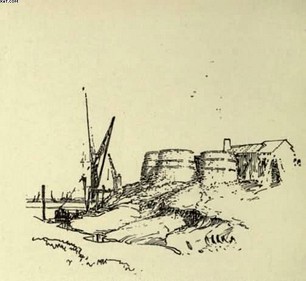
The entrance to Cliffe Creek
I SUPPOSE there is no part of Kent so little known to those whose lawful occasions do not take them there on business as the river-shore, along the northern limit of the county and the marshes below Gravesend backed by a ridge of hill that divides the Thames from the Medway. Of this last tract of country, known as the Hundred of Hoo, no one seems to have a good word to say. The old rhyme gave the dog a bad name—
He that rideth in the Hundred oi Hoo
Besides pilfering Seamen shall find dirt enow.
And writers since have stuck to it. Mr. Walter Jerrold, in his Highways and Byways in Kent, dismisses the whole region in a page and a half, though he allows that “there is much pleasant country to be seen in the wooded hills and cornlands stretching across the central part of the peninsula and a charm in the broad marshes going down to the river.” He says “the villages have not much to detain us except that of Cooling.” Another Kentish topographer, Mr. Charles Cox, in his Rambles in Kent, speaks of the Hundred of Hoo as having “no claim to be picturesque or attractive.” “Probably,” he writes, “this dreary peninsula is the least visited of any part of Kent, and the rambler is advised to shun it unless he is a churchlover.” Guide-books, as far as I can remember, are equally contemptuous.
My attention was first called to this part of the world by the delightful scenes in Great Expectations. For inspiration to a landscape painter it would be difficult to find anything more suggestive than some of Dickens’s word-pictures.
“Ours was the marsh country down by the river, within, as the river wound, twenty miles of the sea. My first most vivid and broad impression of the identity of things seems to me to have been gained on a memorable raw afternoon towards evening. At such a time I found out for certain, . . . that the dark flat wilderness beyond the churchyard, intersected with dykes and mounds and gates, with scattered cattle feeding upon it, was the marshes; and that the low leaden line beyond was the river; and that the distant savage lair from which the wind was rushing was the sea.”
Here is another one— "The marshes were just a long black horizontal line then, as I stopped to look after him; and the river was just another
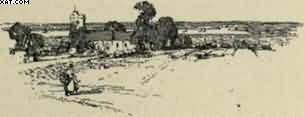
"OURS WAS THE MARSH COUNTRY DOWN BY THE RIVER." “GREAT EXPECTATIONS.”
horizontal line, not nearly so broad nor yet so black ; and the sky was just a row of long angry red lines and dense black lines intermixed. On the edge of the river I could faintly make out the only two black things in all the prospect that seemed to be standing upright; one of these was the beacon by which the sailors steered—like an unhooped cask upon a pole—an ugly thing when you were near it; the other a gibbet, with some chains hanging to it which had once held a pirate.
“It was pleasant and quiet there, with the sails on the river passing beyond the earthwork, and sometimes when the tide was low, looking as if they belonged to sunken ships that were still sailing on at the bottom of the water."
“It was like my own marsh country, flat and monotonous, and with a dim horizon; while the winding river turned and turned, and the great floating buoys turned and turned, and everything else seemed stranded and still.”
These and many other equally effective glimpses of an unknown country fired my imagination many years ago, and, before I came to live in the Medway country, I often rambled about that Thames marshland. I remember landing in a sailing-boat at Cliffe Creek, where there were some curious ruins of long-ago disused kilns. Here is a sketch of them. I struck inland to make Rochester, when on the way I beheld an amazing thing—a crater in Kent.
Now I was going down to the sea in a ship, and it is given to such people to see the wonders of the deep and a few extras on land thrown in, so I ought not to have been particularly astonished. I will recount the tale, however, for it seemed to me worth remembering.
The New GEOLOGY or The Story of a Crater in Kent
One summer afternoon, when the tide had turned against her and when the wind had died down to an almost imperceptible stirring of the air, a small sailing craft dropped anchor off the creek at Cliffe. Her captain and crew, with cheery optimism, had given Rochester as their next address, so it was decided that an expedition for the purpose of fetching letters should be fitted out.
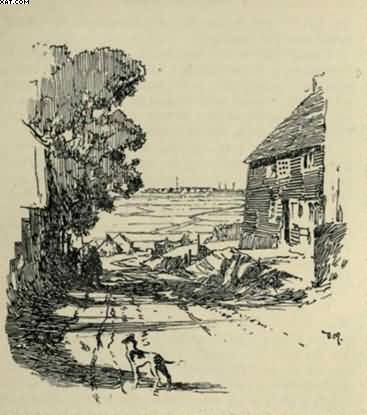
A ROAD OUT of CLIFFE
.
I volunteered to be the expedition. Sketch-book in hand, I started on a ramble which had Rochester as a distant objective, chancing such finds as the landscape of the land could afford. The marshes seemed asleep and the dull and distant beat of the paddle of some steamer alone indicated that the activities of time and tide were still proceeding.
Near Higham I left the marshes and came upon the rising ground towards Great Hermitage, some two hundred feet higher, with broad prospects of the distant river now almost invisible in the haze, led on by the sight of a windmill and some mysterious monument like a damaged edition of Cleopatra’s needle. I could not find out what event or what person this obelisk stood for, but a farm labourer volunteered the information that someone, he had forgotten who, had built it, he had forgotten when, to be seen from the river, he had forgotten why. He also volunteered the information that "The Stone Horse,” the direction of which he pointed out (" Thank you, sir. It is very thirsty weather”), was the departure point for the road into Strood. I thought I would get better acquainted with “The Stone Horse ” and see if I could get the landlady to make me some tea. This, remember, was before the days when it was considered necessary for the defence of the realm to force travellers in country places to wait till six o’clock for a drink, however hot the weather, for the practical effect at most inns of closing the bar in the afternoon is a general exodus of everybody connected with the place, so that the pleasant amenities of tea are no more. At six o'clock it is too late for tea, and by that time the traveller is so thirsty that he will drink the place dry on beer or any other liquid that can be obtained quickly. This state of things is supposed by innumerable simple and well-meaning people to promote temperance.
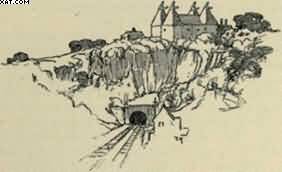
ENTRANCE TO THE TUNNEL AT HIGHAM.
I struck across some fields, dipping down towards a little wood of young larches. The place was quiet and seemed out of the world. The ridge of Great Hermitage hid the region of the Thames, although an occasionally long-drawn note of a siren, distant and attenuated, still told of ships on their way to London. I looked back as I walked, and a little to my left beheld an amazing thing—a crater! The little larch wood, I saw, overtopped a precipitous descent from the depths of which rose wreaths of smoke slowly dissipating themselves in the air as they ascended. Then an ominous rumble. Wonders unceasing, I was just in time for the eruption. The ground trembled, the roar grew louder and then died away suddenly as a column of white steam appeared like a cloud escaping from the nether regions.
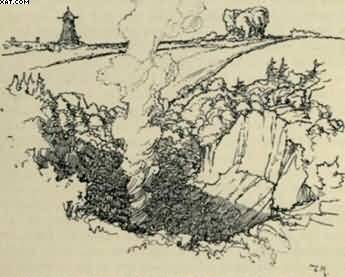
A CRATER IN KENT.
A closer inspection revealed the fact that I was looking down into the railway tunnel of the line between Higham and Strood at a point where there is an opening. It is a place with a curious history. I had, indeed, lost my crater, but instead I found a ghost—the ghost of a dead canal.
Time was, before the railway had come to kill them, that canals were used for the transport of heavy goods all over England. There are few places that are far removed from shipping and the coast that have not some waterway, linking it up with river and sea. Many of these ways are now derelict or disused, as the Wey-Arun Canal or the Royal Military Canal of Romney Marsh. Had not the introduction of railways checked the activities of the canals no doubt there would have developed a much more connected system of inland water transport. I remember once seeing a map of projected canals in Kent. They were to run all over the place. I cannot remember many details, but I know one scheme was to link the Medway with the Royal Military Canal near Appledore by cutting from a point near East Peckham at a cost of £320,000. A bill was passed for this in 1811, but there was much delay, and it was finally abandoned, whether on account of the subsequent foreshadowed railway projects or not I do not know.
The tunnel which now carries the railway from Higham to Strood was finished in 1824 for the waterway known as the Thames Medway Canal. It was twenty-two feet in breadth with a towpath alongside five feet wide, two and a quarter miles long. An amusing account is given by a traveller who went through this subterranean way by steamboat soon after it was first opened.
“After our eyes had become reconciled to the transition to almost Egyptian darkness, relieved, however, by the lurid glare of our flambeaux, we had opportunity to contemplate our rather romantic situation. The steamer filled up nearly the whole channel, and the noise caused by the reverberation of the dash of the paddles in the water, the indistinct light, and the consciousness of being absolutely traversing the bowels of the earth, produced a very odd sensation."
The canal was not a financial success because, owing to difficulties of tide levels at each end, a barge passing through was not able to get out again as soon as she had made the seven-mile voyage. Thus, if there was any wind, barges could often sail round via Sheerness and be up at Strood as soon as through the canal, incidentally saving dues. However, there was a good deal of use made of it by the Maidstone barges.
The South Eastern Railway bought up the canal. The towpath was broadened by carrying out a platform on piles, and on this a single line was laid. A correspondent of the Rochester Journal describes the running of the first train on Christmas Day, 1844. He writes— “I was in Frindsbury Church when the first whistle sounded. After the service the Vicar and Churchwardens and most of the congregation went down in a body to see the wonderful machine. On coming through the tunnel the funnel of the engine struck against the chalk at the top, so they took it down and cut it nine inches shorter before they returned to Gravesend.”
The crater-like opening into which I was now looking was a basin in the subterranean canal for the purpose of allowing barges coming in opposite directions to pass, and a quay for the horses and drivers to do likewise.

FRINDSBURY SHORE.
I returned by this same way at twilight, and then it was that I saw the ghost of the old canal come out to walk abroad. The railway tries to forget its victim, but the ghost won't let it. Trains, brilliantly lighted, tear by, whistling bravely to keep up their courage, and then, shrieking into the tunnel on the other side, make for lights and London, but they cannot escape the memories of bygone days.
Down in the dim depths of that strange chasm invisible barges glide silently to and fro and ghostly feet tramp noiselessly upon the grass-grown quays: for the railway is haunted.
Cooling is generally believed to be the original of “Our Village" in Great Expectations. This is no doubt on account of the tombs in the churchyard, stone lozenges, with rows of little lozenges to commemorate a number of children that died in infancy. These are so exactly described by Dickens that somewhat unreasonably everybody jumps to the conclusion that all the other features of “Our Village" must be of Cooling. As a matter of fact, Chalk contests the honour somewhat successfully, for the church stands on the fringe of the marshes, alone and about a mile from the village.
I live in Rochester, where we have Dickensian Societies and all sorts of controversy about these things. We write to each other and write to the local papers and take sides when Jones and Robinson are at it hammer and tongs as to what in the Dickens is the right place. No one seems to remember that an author may take an artist’s licence and mix things up a bit. It is great fun and adds zest to everyday life.
The principal interest of Cooling (Cowling) lies in the castle with a well-preserved machicolated gatehouse. Built within the area of the walls stands a perfectly modem and ordinary house, looking rather incongruous. Its chief historical interest clings round Sir John Oldcastle, in the time of Henry IV. He was arrested, tried for heresy, and taken to the Tower of London. He escaped once, but was recaptured and executed. The castle held out stubbornly against Sir Thomas Wyatt on his ill-starred march from Maidstone to London in the reign of Queen Mary.
This stronghold was built by John de Cobham in Richard II.'s time as a protection against foreign pirates who had ravaged the district. The purpose for which this old Manor House of Coulyng was thus fortified is still declared in an old tablet affixed to the gatehouse. It is significant that it is lettered in English in a period when almost all such inscriptions and charters were in Latin—no doubt as a sign that it was a defence against foreign foes. It runs—
Knouweth that beth & schul be
That I am road in help of the cuntre
In knowyng of whyche thyng
Thys is chartre & wytnessyng.
My acquaintance with riverside Kent above Gravesend has been made in boats of various kinds. Beginning when I was at school with journeys by steamboat to Greenwich from London I have always delighted in the wonderful shores of our muddy old Thames.
